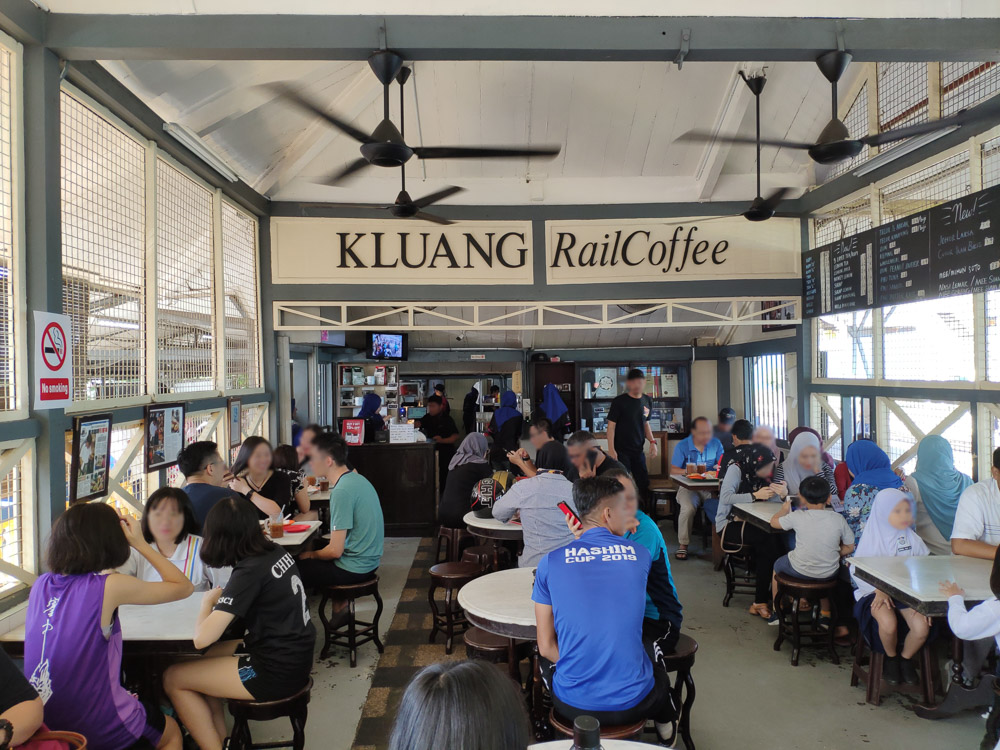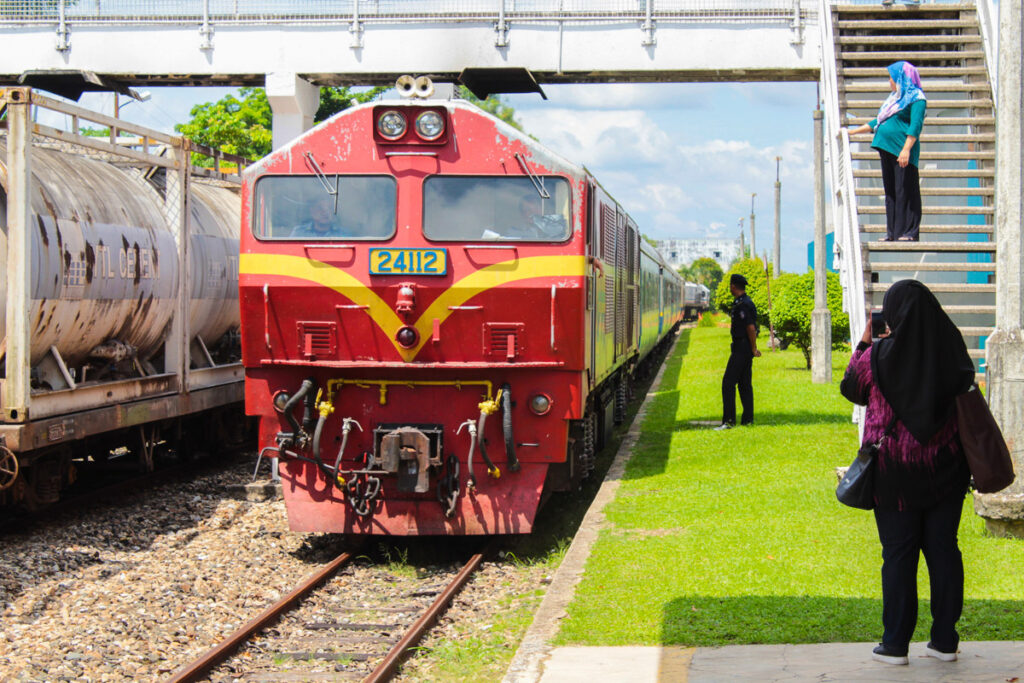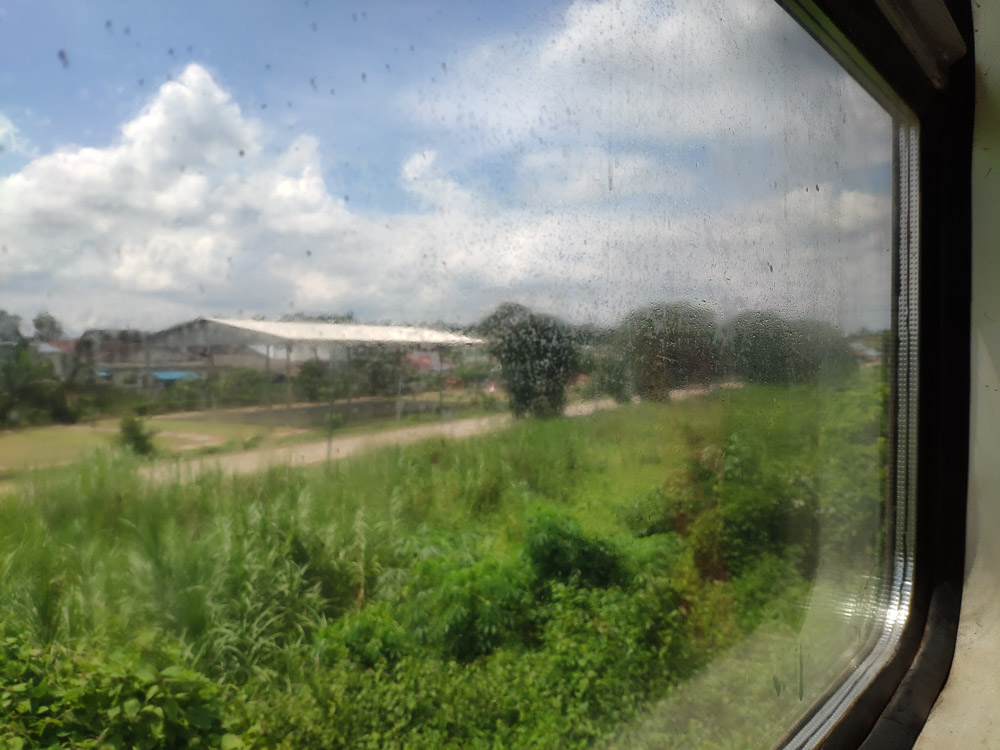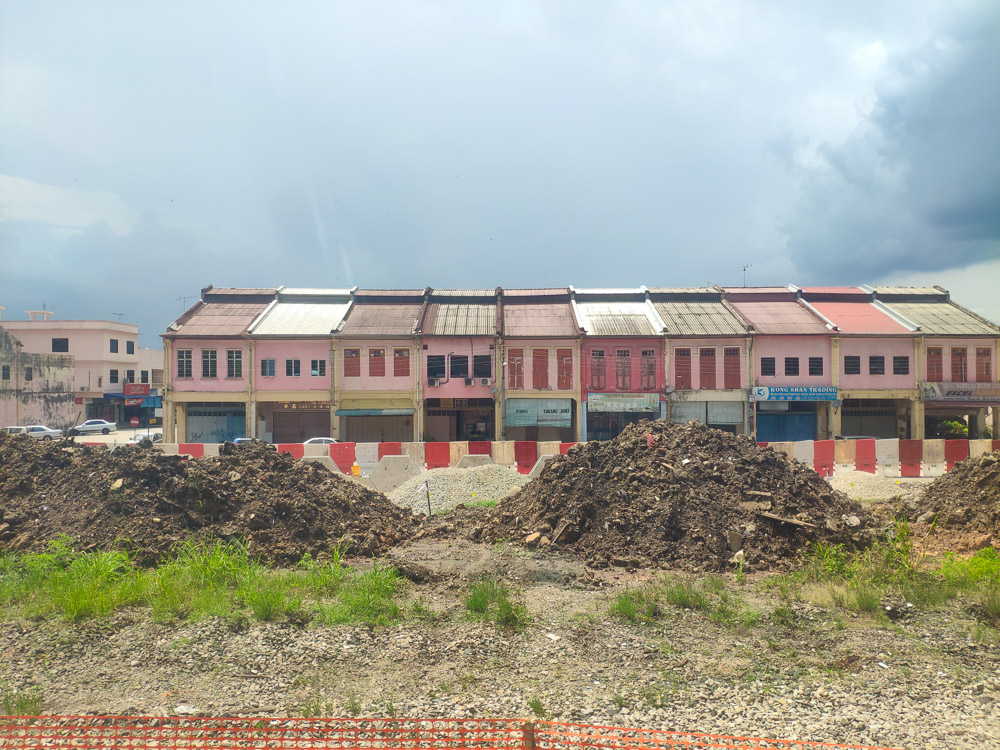I found myself in the town of Kluang for work one fine weekend. Kluang is a pretty nice small town in the state of Johor, and is actually worth a short visit. Unfortunately while I would love to have spent more time in Kluang, weekends end and the work week calls, and I had to make my way back to Kuala Lumpur.
I’d taken a relatively dull bus ride from KL to Kluang on the trip out and while a perfectly legitimate mode of intercity transport, buses can be rather uninspiring. Kluang is, however, an important stop on the southern railway mainline between Gemas and Singapore. As a train trip to or from Kluang was already on my bucket list, my choice of transport back to KL was a foregone conclusion.
First posted 10 September 2019. Updated 19 February 2023.
Booking and Timetabling
Booking my tickets was a relatively simple affair through KTMB’s website. The service running between Kluang and Gemas was the ES40 Ekspres Selatan service. At the time when I was still scouting travel options the ES40 service was timetabled for a 11:21 am departure. This would have put me in Gemas at 1:54 pm, giving me 1 hour and 20 minutes to connect to my ETS service from Gemas to KL.
As luck would have it, KTMB rolled out a new timetable within that same week week, and the ES40 service would now depart Kluang at 12:21 pm instead. This moved the Gemas arrival forward to 2:54 pm and my transit time to 20 minutes. While 20 minutes is usually a workable amount of time for cross platform train connections, KTMB’s propensity for delays demands at least a 30 minutes allowance, or an hour if you’re wary. The alternative was catching the bus back to KL, and as the train was a more attractive mode of transport for me, I swallowed my worries and booked myself onto the 12:21pm departure.
I’d previously taken the Ekspres Selatan end to end between Gemas and JB Sentral as part of my train travel to Singapore. Curiously it was then called the Shuttle Gemas rather than Ekspres Selatan. I’m still not sure if it has always been the Ekspres Selatan or if the service was renamed since then.
Preliminaries – The Kluang Station Kopitiam
Kluang station is an attraction of its own. First opening in 1909, the railway station has been a hive of activity ever since. Key to the station’s prominence is its station cafeteria, better known by its brand of “Kluang Rail Coffee”. The cafeteria has been operating since 1938, and serves coffee brewed with locally grown beans as well as traditional breakfast items such as half boiled eggs. Above all, the Kopitiam is perhaps most well known for their famous roti bakar – Bread roasted over charcoals and lathered with butter and kaya.

With a wait of 2 hours at the station I decided to have my breakfast at the Kopitiam. I felt this was a crucial part of the classic Malayan railway experience, even more so as old-school station cafeterias are going extinct along the Malayan railway network. Meal options at KL Sentral for starters, are commercialised chains like McDonald’s, KFC, and other local brands; Stations along the newly electrified northern mainline, too, do not feature cafeterias. With the southern mainline undergoing modernisation and electrification, train travel along this sector will lose its old time charm.
Progress, surely, but we too can bemoan the loss of nice old things.
Having said all that, of course, I must observe that the Kluang rail kopitiam too has become a brand of its own, with an eponymous cafe available in 1 Utama, unrelated to the original shop but still a far cry from its humble origins.

The cafeteria was already full at 10:00 am and I had to stand in line for a seat for half an hour. In the meantime, the station saw the arrival of the Ekspres Rakyat Timuran from Tumpat, rumbling in at 10:20 am instead of its original scheduled arrival of 9:47 am. Classic KTMB.

Over my morning roti bakar and kopi I got chatting with a a local pak cik with whom I shared a table. He reminisced about a time when Kluang station saw more traffic than the twice daily Ekspres Rakyat Timuran and 6 times daily Ekspres Selatan (3 & 9 hours apart!), stories from an era that predates me. While the upgraded mainline will see fast and sleek electric trains zipping up and down, nothing really beats the sight and sound of a loco-hauled set rumbling in and out of the station.
With breakfast done, it was time for the remainder of the 2 hour wait.
Departure experience at Kluang station
Kluang station has a simple layout composed of a single station building and 2 platforms, with Platform 1 located on the colonial era single tracked line and Platform 2 on a passing loop line. Trains usually used Platform 1, with Platform 2 seeing rare usage owing to the sparse timetabling.



The mainline south of Gemas is in the midst of being double tracked and electrified. As part of the upgrading works, a the old colonial era alignment is being replaced by a new alignment supporting speeds up to 160 km/h all the way to Johor Bahru. The most visible sign of the works at Kluang at that time were the newly constructed pillars for the viaducts that would carry the new elevated tracks through Kluang. Kluang station itself will also be replaced by a brand new elevated station.





The first indication that the train was not on time was the presence of a freight train occupying Platform 1, the station’s main platform in use. As 12:21 pm crept closer passengers started to gather on the platform with slightly confused expressions, with one enterprising passenger asking station staff for updates.
The update was quite simple – our train was delayed, and this proved to be the case as 12:20 pm rolled past without an intercity train in sight.
Under other circumstances I would have been somewhat indifferent given my previous experience with KTMB, but on this occassion I had a crucial ETS connection to make. With the 20 minute allowance running down I was left fighting a rising panic.
Station staff eventually asked that we cross over to Platform 2 instead. Compared to Platform 1, the sparsely used Platform 2 features a rather 1950s looking concrete shelter and a grass patch as part of the platform. Pretty retro!

Some 10 minutes after its scheduled departure time the Ekspres Selatan came rumbling into the station, with the consist led by Hang Nadim painted in retro Malayan Railways colours. The boarding process was orderly with passengers waiting for those onboard to disembark before boarding themselves.

A quick look down the platform and I climbed onboard the Ekspres with my suitcase, only to turn the corner and saw my reserved seat occupied by the train’s caterer and his refreshments trolley. This wasn’t an issue, and I simply took another seat of my choice that happened to be backward facing in the less crowded rear part of the carriage.
The loco gave a tug and we were off trundling down the mainline northbound. With a journey time of approximately 2 hours and 30 minutes, I quickly settled in and made myself comfortable with a book I’d brought along.
Cabin & Onboard Amenities
The consist was made up of the Class 24 locomotive and four Hartasuma ASC coaches. The body shell of these coaches were made in India but the interior was fitted locally. All four coaches were Air Conditioned Second Class coaches.
The cabin onboard these ASC sets were not the original interior they were installed with, as the carriages were refurbished some time after their original introduction to service. The refurbishment clearly extended to the seats only, as the remainder of the carriage (the panels, doors etc) were visibly showing their age and wear. Doors between the carriages, for example, had a propensity to get stuck and required some amount of force to get them to slide; While the cabin walls featured curved supports for the overhead racks, a longer glance at the panels and fixtures revealed some non-functional light tubes and bent ceiling panels.


Unfortunately, this level of care given to their train sets does reflect badly on KTMB.

2023 Update: Since this ride, KTMB has largely retired these coaches, with the remainder being given a comprehensive refresh by Padu Sedia Sdn Bhd.
The Air Conditioned Second Class seats
The Second Class seats onboard each carriage were in a 2-2 configuration across 10 or 11 rows. Half of the seats were installed facing forward, and the other half were facing backwards with the two halves meeting in the middle.

The seats were quite well padded, comfortable ,and had good legroom. A plus point was that they could also be reclined. This is a small but important feature that I had come to miss when travelling aboard European trains.
Every seat had a tray table installed on the seat backs. These were sturdy and bigger as compared to the ones installed on the first generation Class 93 ETS sets, but not quite as hilariously big like the ones on the Irish Rail Mark 4 carriages.

Onboard Amenities – The Toilets
Two types of toilets were fitted onboard these ASC coaches – a western style toilet, and an “Asian style” squat toilet. Both toilets previously expelled its waste into a septic tank, but at some point the tanks stopped working and was removed. At the time of my trip, the toilets worked by expelling the waste directly onto the tracks – Yuck.


The sink was small, but at least the tap worked. The problem with the tap was that it was pointed not into the sink, but was angled over a spot just before the sink cavity.
I must say that at the very least the door for that particular western style toilet worked. The squat toilet just opposite it had a rather curious malfunction of the door – One of the side hinges had rusted out, and so the door was left dangling by the remaining hinge and held in place by virtue of it being stuck to the upper door frame. This basically meant that the door was swaying like a solid curtain every time the train swayed. Very fun.
Onboard Catering
The Ekspres Selatan is not equipped with a buffet car. Instead, a trolley service is available with easy to make drinks and snacks, meaning it is more likely to be able to buy a cup noodle instead of a pack of fried rice.
Commentary – Service standards on KTM Intercity
KTMB is in the midst of a transformation. On one hand it runs modern electric trains up and down the electrified double track between Gemas, Butterworth, and Padang Besar in the north; On the other hand the rest of the Malayan network is made up of the legacy colonial single track network, with the line starting in Singapore, running across the Causeway to Johor Bahru and northwards to Gemas. It is at Gemas where the line then splits between the modern electrified West Coast mainline to Butterworth and Padang Besar, and the East Coast mainline where the colonial single track continues on to Tumpat in Kelantan.
This duality is reflected also in the standard of service aboard KTMB’s trains. While the ETS run on time and according to schedule, the legacy services on the colonial mainline, like my Ekspres Selatan, are a different world altogether. Run under the older “KTM Intercity” branding, things are much more relaxed and there is a greater possibility of your train being delayed at some point. The delays aren’t exactly KTMB’s fault, as the single track alignment limits speed and capacity. But you get a sense that while KTMB has poured its efforts into the flashy new ETS, the older Intercity services have been left to do its own thing.
I got a look into the chilled vibes on KTM Intercity when the conductor came round to check my ticket. I mentioned to him that I had an ETS connection to make at Gemas, and I wanted to know if we would be able to arrive on time. His response was a self-deprecating and humorous remark that I could wave at the departing ETS train instead.
Elsewhere in the world, that response would have been cause for horror. But at that very moment I couldn’t help but to chuckle as well. After all, it is accepted that anything can happen to a KTMB schedule, and this is an implicit expectation when hopping on a legacy KTM Intercity service.
The view outside – Contrasts
The southern mainline runs largely through palm oil plantations and through the centre of the towns it serves. This meant that stations in towns like Kluang and Labis enjoy extremely easy access from the urban centres, and very much helped to make the railways a preferred mode of connectivity.


The cut in frequencies and the rationalisation of services by KTMB however, means that buses are now saner choices than the train due to the more frequent services. But what you don’t get on the bus are views of local towns, villages, and plantations as you rumble by on a classic locomotive hauled train. In a sense, the view you get along the southern mainline really drives home the importance of the railway as an important mode of connectivity for these towns and villages. Up until that time, the view was also a window into the past when the colonial single track line was being used more heavily than today.
Because where else would you be able to see a station like Chamek – A small wooden building by the tracks with wooden planks as the platform, all setup just opposite a row of wooden houses along Jalan Get?

The railway also gave me my first view of the towns of Bekok and Labis, both places that up until a few months ago I’d never even heard of. In both places the land beside the station had been cleared to accommodate the new station buildings and the double track, and in Bekok in particular, an alighting passenger utilised the cleared land as a crossing to get across to the town. Whatever works I suppose.


As the train neared Segamat the main road slid in right alongside us. For the entire stretch our train rumbled alongside the many cars and trucks, gleefully bypassing the congested, assembled mass of vehicles at the traffic lights and level crossings. Alas this scene would not exist in 5 years time, as the double tracking works will see level crossings removed.

Arrival at Gemas
2 and a half hours after departing Kluang, the Ekspres Selatan throttled back and rumbled into Gemas. Somehow despite the delays, our train had managed to arrive 10 minutes before the ETS’s departure, using up only half of my 20 minutes transit time. As interchanges at Gemas are often cross-platform, boarding the ETS service was simply a matter of walking casually out of the Ekspres Selatan into the sleek Class 93 electric train idling opposite.

The conductor had notified connecting passengers to head on straight to the ETS without delay, and the passengers took it as instructions that they should hurry. For a brief 3 minutes, platforms 3 and 4 at Gemas saw hurried walks by harried passengers as they attempted to locate their train carriages.

Yours truly also thought it would be prudent to be quick in his transfer, leaving him with this lacklustre view of the Ekspres’s carriages now idling at platform 3.
Final Thoughts
This was my last ride on the colonial single tracked mainline in Johor before the upgrading works removed the original alignment in entirety. As I update this post in 2023, a good portion of the mainline now runs on new and stable track bed. Anecdotally, the locomotive hauled trains are now running ahead of schedule thanks to the higher speeds allowed by the improved track bed.
Railway travel will never be the same again for the entirety of the west coast and southern Malaya. With the upgrades expected to be completed in 2024 – 2025, Malaysians can expect a quantum leap in train services from Johor Bahru to Kuala Lumpur.
One day in the far future, people will forget that getting to Johor Bahru from KL by train once took more than 6 hours.

Comments
One response to “KTMB: Review of the Ekspres Selatan from Kluang to Gemas”
[…] took the train to return to KL a day later which you can read about here. It is important to note, though, that while the unelectrified line is certainly charming and […]